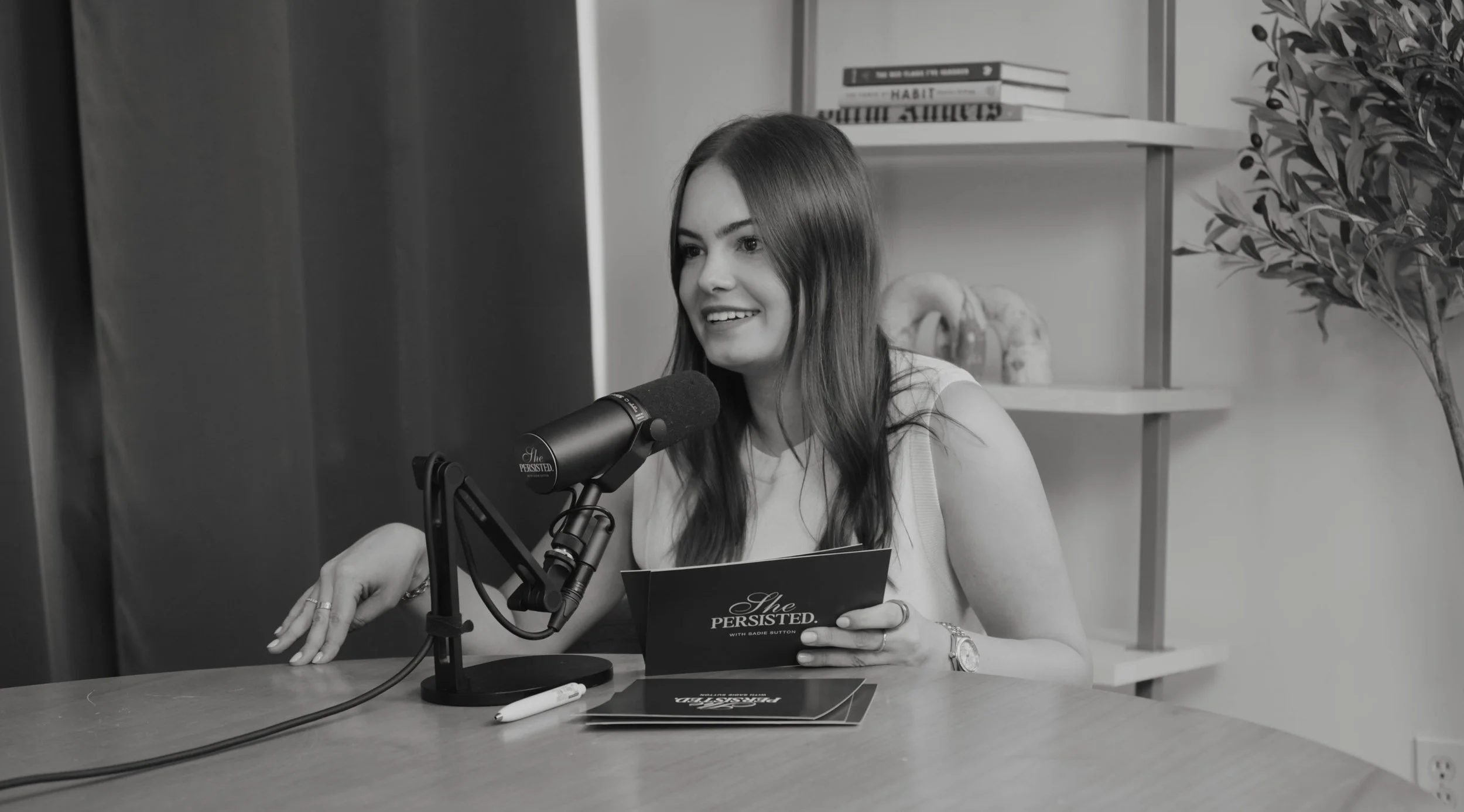236. the 🦋 BUTTERFLY EFFECT of mental health?!
listen to this episode:
Tune in and subscribe on your favorite platform: Apple Podcasts | Spotify | YouTube | Amazon | GoodPods | Castbox | iHeart Radio | overcast | pocketcasts
how can you break unhealthy cycles for GOOD?! in this week’s solo episode, i’m sharing the butterfly effect of mental health. i’m breaking down how your thoughts, emotions, and behaviors are all connected and the one simple step you can take to change your most problematic tendencies!
i talk about:
what your emotions are really telling you
understanding how your emotions are impacting your choices
vulnerability factors when it comes to your mental health
the impact that feeling an emotion has on your body
consequences of avoiding or ignoring your emotions
figuring out your mental health problem areas (unhealthy thoughts, behaviors, etc)
the butterfly effect model for fixing your mental health problem areas
how this model works in the real world (with a step-by-step example!)
an easy guide for trying this model yourself!
Mentioned:
SHOP GUEST RECOMMENDATIONS: https://amzn.to/3A69GOC
About She Persisted
She Persisted is THE Gen Z mental health podcast. In each episode, Sadie brings you authentic, accessible, relatable conversations about every aspect of mental wellness. Expect evidence-based, Gen Z-approved resources, coping skills (lots of DBT), insights, and education in each piece of content you consume. She Persisted offers you a safe space to feel validated and understood in your struggle while encouraging you to take ownership of your journey and build your life worth living.
a note: this is an automated transcription so please ignore any accidental misspellings!
solo ep
Sadie: [00:00:00] Welcome to She Persisted, the Gen Z Mental Health Podcast. I'm your host, Sadie Sutton. Let's get into it. by the end of this episode,
you will know how to change the patterns that are problematic in your life.Next time you are like, I don't know how I got here, but I
don't like where I'm at. You're going to make one small change that has a really big result. Hello, hello and welcome back
to She Persisted. We are in studio today if you're watching and we are doing a solo episode all about how to change
the behaviors that it feels like you just spiraled yourself into and don't understand how you got there. And I am calling this
The Butterfly Effect for Mental Health. What one small change can we make To have a really big impact on our emotions and the outcomes
in our lives. So let's dive in. If you've ever looked back at a situation and wondered, how did I end
up here? There is a psychology map for that, and it can actually change the way you react and approach situations
next time. think most of us would agree that Gen Z is more self-aware than [00:01:00] ever. We know what's happening, but we still
repeat a lot of patterns that are harmful to our mental health or physical health and One of my favorite skills from DBT
is chain analysis and it shows us why we might repeat these things that we know are harmful, but choose to
engage in them anyways. And when we understand the complicated nature of these behaviors, We know
why we keep falling into the same patterns.
because single behavior is not an isolated incident. It's built from tiny connected links that are built up of thoughts, feelings, urges, and choices. So by the end
of this episode, you will know how to trace your chain and identify exactly where to break it, to change the patterns that are
problematic in your life. So we're gonna talk about what underlies these problematic dynamics, which is emotions.
You guys hear me say this all the time, but emotions are not random. They don't come from nowhere. They are messengers
And they exist to help us survive, communicate with others, and also motivate action.
Sadness tells us that we've experienced [00:02:00] a loss and so we isolate and withdrawal to avoid losing further resources. Shame tells us that we've gone against one of our values, so we go within to reflect on that
And avoid repeating the same transgression in the future.
Joy tells us that we have something in our life that we value and want to re-experience, and so we're motivated to go out and acquire more resources and do more things that make us happy
So your brain isn't being dramatic. It's trying to protect you And keep you alive. And To give you guys a little bit
more background there, I love this wisdom from the DBT worksheets about emotion regulation, it's helpful to understand why emotions
can cause us to act so impulsively or. Engage in behaviors that seem so intense, and that's because emotions,
bypass the process of thinking, considering all the options in a situation, they hardwire us to act immediately again to
help us survive [00:03:00] and thrive. and so they can be helpful when we don't have time to think things through. But
in today's day and age, we almost always have time to think things through,
and so acting without considering the consequences is what can lead to that chaos and overwhelm.
Another thing that's challenging here is that I think a lot of us experience our emotions as unchangeable or as a given. We interpret it as a fact about a situation, but our emotions aren't facts.
They're a response to facts. And if we assume that our emotions are facts, we use them to justify our thoughts
or our actions. And this can cause a lot of problems and a lot of chaos when we ignore the facts and rely
only on our emotional responses.
So let's dive into why you're experiencing what you are, how you got to that point, and how it's resulting in the choices and behaviors you make in your life.
So this is where the DBT chain analysis skill comes in, and if you've [00:04:00] ever said to yourself, I don't know why I just did that,
this is going to break it down for you. So what we do in a chain analysis is we break down
every step of the emotional experience and then we go and look at these links to see where we could potentially change the outcome.
So before we are ever in a situation, we have these things called vulnerability factors, and these are things that make us more susceptible to
experiencing intense emotions. So that is things like. Not sleeping well, having had a big argument with a friend the day
before, forgetting to take your meds, being hangry.All of these things have a really big impact on your emotional outcome, and
it's not just these simple things that are more related to the biological experience, but it's also your baseline that
you're functioning at. If you are going through a really stressful time at school, if you have family members that
are struggling with their health, all of these things add to that baseline level of functioning and mean that we're
more [00:05:00] vulnerable to experiencing our emotions in a way that's ineffective. and so on top of these vulnerability
factors. We have a prompting event, and this is what initially invokes the emotion. You get a text, you see
someone you weren't expecting to you. Get a grade on a test and it's not what you want it's the event
that causes the emotional response.
And we don't just experience an emotion in response to that. There's a number of things that happen simultaneously. We have an interpretation of the event, so we have thoughts and beliefs about that thing, and we've talked a lot about. How you think about things that happen has a lot of power.
So if you fail a test and your interpretation is, I'm a bad student, I'm not smart, I am failing this class, we know
that there's a lot of negative implications when it comes to how you cope with that situation if you try to problem solve
it, and also your self-esteem and how you view yourself as a whole. and the inverse is also true. So if [00:06:00] you failed the
test and you say, I could have studied more, that wasn't reflective of what we learned in lecture or I didn't do well on this
test this time, but I'll do better next time. Seeing that situation as specific to that context,
independent of your value and you as a person and also changeable in the future, you
have a much more effective outlook on
the experience as a whole. So at the same time that we are interpreting the event and thinking about how we feel about it, there's also all the biological changes that happen. So this is a lot of what you hear about on TikTok with fight or flight.
rewiring your nervous system. this is the part of the emotional experience that a lot of people speak to and work to change.
So There's a lot of nervous system changes that happen. You might feel more physically tense.
You might feel your heart rate increase. You might be more aware of your surroundings or less aware of your surroundings.
This is the emotional response [00:07:00] that is physical as well as mental. And then you have your experience. So
there are those bodily sensations, those feelings that we're having about the experience in response
to the event, and then also the action urges. Are you feeling motivated to go to office hours and argue for a better grade? is your emotion
telling you to go back to your dorm and isolate and withdraw and have a pity party about that test for the rest of the day? In
addition to the biological changes and the experiences, we also have the expressions of the emotion. So this is our
face and body language. These are your words, what you say, but also what you think and your actions. And these two things
feed into each other. How you express the emotion impacts how you experience it and the biological changes, but your
experience of the emotion and the biological changes also inform how you express the emotion.
at any point within this process of [00:08:00] experiencing and expressing the emotion, we have an opportunity to name the emotion, to recognize what we're experiencing, to be more aware of it, to then adjust the experience and expression. Alternatively, what a lot of us do is instead of naming the emotion, naming it to tame it and being aware of the situation to then change it. Instead, a lot of us will go back to that
initial prompting event by experiencing a secondary emotion, by feeling something about the way we're feeling.
So you fail the test, you get the bad grade, You then feel really sad about your performance. You wanted to do better. You wanted a better grade,
you expected more of yourself. You then start to feel angry about, why didn't I do better? Why am I not a natural test taker?
You are now having a second emotion in response to the initial event. And so we call this a secondary emotion and an after effect, and
then we have a second prompting event, which is our
[00:09:00] additional emotional response to our first emotional
response. And so you can see how this becomes a really overwhelming, chaotic experience that you're just feeding into yourself with these
potentially negative thoughts and experiences, not naming and understanding your experience and just causing a larger and
more overwhelming reaction. And so what we'll learn is how to break that cycle to stop that thought spiral from happening and
change the outcome, but also the experience of the emotion and how we express it. And to zoom out a bit bigger picture
in the moment, it's not fun to be like really caught up in the emotional experience and overwhelmed with what you're feeling and just like feeding into that
experience. but what a lot of us dowhen we experience a negative emotion is that we try to escape or avoid that experience because
it's not fun, it's not enjoyable, it's uncomfortable, and in our attempt to escape or avoid it, we engage in these problem [00:10:00] behaviors or ways
of coping with the experience that are not effective and you experience relief that is temporary and momentary. You don't get the experience to
learn how to approach this differently in the future. You don't learn new skills, you don't build that. sense of mastery, and then you in turn have
another vulnerability factor, which is that the next time you experience this emotion or this stressor, you're more likely to do that same
thing, which is feel negative emotion, escape or avoid it, engage in the problem behavior for temporary relief, and never learn
to be aware and adjust the experience. so notonly is there a lot of implications around the experience in the moment, but also what will happen
in the future and how you will respond to stress next time you experience it. So the best part of DBT is that
we always have a choice when we react. We might not be able to avoid the initial emotion.We might not be able to avoid those automatic thoughts
[00:11:00] that come up, but we can either choose a path of judgment or a path of mindfulness. And so when we approach
the situation with judgment, that's our interpretations, our assumptions.We're comparing it. We're asking ourselves, well, what would that other
person do in this situation? Why am I not acting that way?And that path leads us to self-regulation,
shame, anger, fight or flight, shutting down, really having a negative experience mood wise versus when we go with a path of mindfulness and
notice what are we experiencing?What are the facts of the situation? Accepting These are the cards that I'm dealt at
this point. What can I do going forward? We then are regulating our emotions, and that's skills like radical acceptance, opposite action, breathing, and
grounding. So chain analysis is looking at all these individual components of the emotional experience and our response, and we can really simplify
it. It's those vulnerability factors. So what did we come into this situation with already, kind of being at a loss. Were we [00:12:00] tired? Were we stressed?
Were we sleep deprived? The prompting event, what happened that resulted in the emotion? And then we have these links that we can
disrupt. So how we thought about the experience, what the bodily sensations were like, the physical experience of the emotion, the emotion itself, the urges that were associated with experiencing the emotion, and then what actions we took to either cope with that experience or try and change it. and
the consequences are in true DBT fashion A dialectic, which is that short-term relief versus long-term pain and understanding how we want to approach
the situation so that it's easier for us to navigate next time. And again, avoidance feels good for those five minutes, but it's the reason that you're stuck in this cycle. So
how should you be approaching this in your day-to-day life? The first thing is understanding what is the problem behavior that I am analyzing. And I don't want you to [00:13:00] just
limit yourself to a behavior, though that's likely what you're analyzing if you are in DBT or in crisis. And But the problem behavior could also be avoidance.
it could be things like not being vulnerable and asking for help when you go through a challenging emotional experience.
It could be the way that you think about the experience, like we talked about, how you respond to a failing grade on
a test.It could be that secondary emotion, like having those thoughts that led to anger orshame or lashing out. But it can also
be these really tangible actions that we take in response to our emotions that oftentimes make things worse. So after something bad
happened, did you avoid, Did you not tell anyone? did you punish yourself for the experience? What are the ineffective ways that you responded to that emotion?
You guys have heard me say this before, but if we don't have awareness, we can't take action to change the experience. So really understanding what you want to [00:14:00] change allows you to shift that experience.
But if you don't know if you're targeting the thought or the emotion, or the behavior or or the conversation you had, you're not able to
adequatelyapproach, understand, and change that situation.
The other part of a chain analysis which people tend to get wrong is the prompting event, which is that a lot of times when we think about why we're experiencing an emotion, we attach a lot of judgments and responses to
the initial prompting event. So if you get in an argument with a family member, you might be like, the prompting event was, my sister was rude,
or my brother was annoying.Or if you failed the test, you might label the prompting event as I'm a horrible test taker,
but that's not the prompting event. That's your interpretation of and your response to the prompting event. and we need to be really
clear on objectively what occurred, purely describing the facts that took place. So the prompting event would be like, I got a phone call,
I [00:15:00] received a grade back on a test. Like, what can you observe and not attach any judgements to. Because again,
your interpretation of it, your thoughts about it, how you felt are those subsequent links in the chain and how you responded to
that initial thing. thing. And afterwe are able to solve the event, we also again think about what were our vulnerability factors. And
I think vulnerability factors was something that allowed me to give myself a lot more grace and experience my emotions less intensely. Because one of the
best ways to self validate or for others to validate us is to say it makes sense that you feel that way. It makes sense that that would be your response. It doesn't
mean that it's a justified response, but when we understand kind of the cards that were stacked against
us or the things that led to this emotional response, we're able to give ourselves more grace and recognized that it wasn't this isolated event that led to this feeling. It was a combination of. The stress from the last week and the last month and how I [00:16:00] slept last night and if I was hungry,
and all of these other factors that also contribute to the experience. Because emotions don't occur in isolation. Our responses don't either. And
when we can understand that, we can really break down the experience and target a really specific part of it to then change
the rest of the chain.
So when you're doing a chain analysis, you've identified, okay, what was the problem behavior? What was the prompting event? Purely, objectively, no judgements attached. Then you go through every single thing that followed. So the actions, the sensations, the. Thoughts you had, the events that occurred, the feelings, the emotions you felt about, the feelings you were having, getting really, really detailed in understanding how this cascade of events occurred How
you ended up in this chaotic thoughts spiral outcome. And when we're able to break it down and understand it
in this way, it doesn't feel as overwhelming and out of our control because we can really clearly see, okay, A led to B and B led
to C, and that's how
[00:17:00] I ended up in this spot. But I can also do things differently next time and get a different outcome.It feels less out of control, it feels less overwhelming,
and there are actual steps you can take to improve the experience.
In early days of DBT, almost every single session I was doing a chain analysis and sometimes it was like, why didn't I call for skills coaching when I was in crisis? Or why did I engage in this problem behavior despite the fact that we talked about last time I would try to avoid doing that this week? Or why did I have that giant argument with my parents? That was the most stressful thing since the last time I was in a session and.In the moment, I think there's like the voice in the
back of your mind that's like, I know what I should do, but I'm not gonna do that. When we break it down into these really specific parts of the
experience, it's much easier to make a tiny change that then shifts the outcome versus trying to get yourself to approach the situation in a
completely different [00:18:00] way.
Because it feels a lot safer to do what we've done before, and it can be really overwhelming to try and approach a situation completely differently and rehaul the whole experience. So this feels a lot more doable.
It feels less overwhelming to change one tiny link of the chain and therefore adjust the outcome ratherthandoing a complete overhaul Because so,
I think you're really setting yourself up for failure by expecting yourself to do something completely different that you've never done before, despite
having a really reinforced pattern of response and behavior.
it's just, it's unrealistic as an expectation to set for yourself, and then you feel more shame and anger, and then you're in. a. Whole other emotional response. So it's really the butterfly effect for emotional experiences. One small shift can completely change the outcome, but you can't make that shift unless you understand how the cards fell.
and I said, I was doing chain analyses on the weekly in therapy sessions. I wasdoing them [00:19:00] outside of sessions. There was an abundant lack of understanding. As to how I was getting myself in these really ineffective ways of coping with things, why I was reacting so ineffectively
to these seemingly inconspicuous prompting events. and wasn't going through these steps of understanding in
my head. It wasn't something that was naturally happening that like, oh, I have this conversation and that is actually reminding me about this like negative belief I had or this conflict that I had last week or I
just go right into that negative way of coping because it's what I've always done before, or i'm avoiding because this is uncomfortable and I
don't want to sit with this. There was not that understanding of what was happening, and so the emotional experience
felt really overwhelming and out of my control, and I would just end up in this really bad spot without understanding how I got
there, but also how I could change it in the future. So when we break it down to be really micro little steps. We're able to shift that and change
that, which is a [00:20:00] really empowering experience and gives you a lot more control over the outcome.
So. So Essentially, when I was in treatment, I was using this to figure out why every single tiny setback was turning into an entire spiral. And once I saw the links between each step, I finally had
options about how I could change the situation. So you are confused about how a chain analysis works. Why this can have an impact
on the outcome. I want you to remember that you can't delete emotions, but you can rewrite the sequence that they occur in.
in. So we're gonna go through a \real life chain analysis example, one that I think almost all of us can relate to, which is doom scrolling. and I think that's an example of something that happens seemingly automatically, that you're not understanding how you got 45 minutes down the TikTok for you page and
didn't do any of those other goals that you set for yourself.
When we unpack it as a chain analysis, we're able to understand exactly how we got there and what we can do differently next [00:21:00] time. So I will do
this for me, but you plug and play your situation, your context, to understand the outcome. So. My most common doom scrolling time is I will get
back from work and I will sit on the couch and I will start scrolling on TikTok and all of a sudden it's been an hour, and then I. Decide, oh well, like I don't
have that much time left. I can't do work and it's kind of late, so like, it's not really a great time to like eat dinner because then I can't go
to the gym, but I don't really wanna go to the gym because I'm gonna have to make dinner. And then I end up doing none of the things. I don't
do work. I don't go to the gym. I don't end up
eating dinner until really late and it's not planned. And then I'm like, okay, I did nothing with my evening except for Doom scroll, because I convince myself that was the only reasonable path forward.
So in that situation, the vulnerability is that I'm a little bit brain dead. I've been at work for nine hours.I'm tired. I haven't eaten since lunch. maybe I didn't
sleep super great the night [00:22:00] before, so I'm not operating at my best.
Maybe it was a stressful day at work. Maybe there was a project we were working on.
that is the vulnerability.
The prompting event is me getting home and sitting on the couch.
You can kind of adjust this, but I think it's helpful to think about it from a habit lens of like, we have a queue and a response, and for me the queue is if I'm sitting on the couch, I will then take out my phone and open TikTok and scroll. So. It would be harder for me to say I'm gonna sit on the couch and then change the behavior to, I'm gonna read a book or I'm gonna call someone because the cue is sitting on the couch. So
if I don't sit on the couch, I'm much less likely to then doom scroll for three hours. The prompting event is me getting home and immediately going to sit on the couch. Once I sit on the couch, I say, okay, I'm bored. I have nothing to do. I'm gonna open my phone. And once I open my phone, it's almost like that automatic wild reaction of I open TikTok or I open Instagram.
Like that's the first thing I do because when I sit on the couch, I open my phone and then I [00:23:00] go on TikTok, and then I scroll. When
I open TikTok, I see a video that invokes an emotion. Maybe it's funny, maybe it's sad. There's an emotional. Response and then I am having a secondary emotion and scrolling to change the emotion or see what's coming next. And then you're having this like whole emotion reinforcement cycle related to scrolling. And that's how you end up
doom scrolling, right? Like you end up in this cycle of emotions and experiences that we talked about. And at no point do you
intervene and change the outcome.So essentially I scroll, I then have these thoughts of like, well, it's not a great time for me to eat dinner
because then I won't be able to go to the gym later. But also it's like kind of too early to go go to the gym now. And also I just got
back from work, so like I don't wanna do additional work now. Like these are the thoughts and the interpretations about the
prompting event that I'm having. Are they accurate? No. I could do any of those things, but those are the thoughts that I'm having.[00:24:00]
And then once I am like, well, it's not a great time, so I'll do that later, and then all of a sudden
it's been three hours, I then I'm thinking to myself, I did nothing with my afternoon. I have nothing to show for this evening. I could have done
something that was more Productive and fun, and I feel like low energy and not great about the experience, and now I'm annoyed at myself.
I'm having a secondary emotion for scrolling on TikTok for three hours.And
those are the consequences of the event. And this is something that we don't always take the time to unpack and consider, but the consequences are the reason that we're changing the problem behavior.
Behavior might not be great, but if there's not consequences, there's not really the motivation for
us to change it. So it's really important to understand. How did other people react? Not only in the moment, but later on. How did you feel immediately following the behavior, but also later on? So for me, I was like, okay, I am annoyed at myself for scrolling for three hours. Shame, anger, frustration. Anxiety
about all the work that I now have to do and things [00:25:00] that I didn't end up getting done. later I am more
likely to repeat the cycle and sit on the couch, open my phone, go on TikTok and Doom scroll. And what effect did the behavior
have on the environment, both in the moment and later on, I mean, maybe I didn't like tidy up my apartment or get work done,
and that impacts both the productivity or the outcome in the moment, but also the work that I have to do the next day or the day after. And it
just like compounds and piles up and then is overwhelming, and then you avoid it by doom scrolling and going on TikTok. so
we're able to understand how all of those things happen. And for me, I think the most. Effective way to change that is not opening TikTok and then trying to get
off of TikTok. It's not sitting on the couch and then trying to convince myself to read a book rather than watch entertaining content.
What's most effective for me to change, I think, is sitting on the couch, which is that instead when I get back from work, i
put my stuff down and maybe I like put on an outfit to go to the gym or maybe I immediately start making dinner. Maybe I [00:26:00] start tidying
things up. Not doing that cue, that results in that behavior.That for me, is the easiest link
to break. And as a result, I don't have the emotional cycle of doom scrolling for three hours and then feeling annoyed at myself
and then having more work to do, and then feeling overwhelmed and then doom scrolling for three hours to avoid feeling overwhelmed
because I was doom scrolling for three hours and caused myself more work down the line. So it's not about being perfect. It's about catching
the pattern one link earlier each time, likely what will happen and what does happen when I try and shift this behavior is sometimes I
do sit on the couch but do a different activity. Sometimes I do go to the gym, but then I scroll, but for less time, it's moving in the right direction and understanding how these things occur and happen so we can insert ourselves and get a different outcome.
So if you've never done this before and you're like, this feels really overwhelming and I don't want the really long, extensive, intensive black and white DBT worksheet, I would just like some nice questions to [00:27:00] ask myself to consider.
You're going to write the event that happened. Completely object. Objectively, just the observable facts. You're gonna write your thoughts. Feelings,
actions. And the outcomes. The outcomes in the moment, but also long term. And you're gonna highlight or circle where you could pause next time to do something
differently. Is it before you sit on the couch? Is it before you look at the response to your test grade? is it before you send that text? And you are gonna
circle that moment and decide what skill could I do to change the outcome? So for me, it's. Stop. I'm gonna pause. I'm gonna think,
okay, if I sit on the couch, I'm very likely to go down a TikTok rabbit hole and doom scroll for three hours.If I don't go on the couch, I will do something different.
And maybe I still will like not be super productive and get all the things that i wanted to done, but I won't end up in this doom scrolling shame spiral for
three hours and. Even the understanding is a movement in the right direction, right? Like we don't have awareness, we can't take action to [00:28:00] change
it. So even just going through the chain analysis, even if you still end up doing the thing, understanding where you could do things differently and why
you're getting the outcome that you are in your life is really helpful.
Sonext time you have a behavior or an experience that you want to change. I want you to think about it from this butterfly effect chain analysis framework. One small thing can have a really big impact on the outcome, but if we don't break
it down into those little small things, we can't understand where we can insert a scale and be more effective.
So remembering that Every behavior that you want to change makes perfect sense when you zoom out. That is the power of a chain analysis.
It is turning that shame into insight and insight into change.And like we said at the beginning, it's not impossible to change these things. It's not an
uphill battle. You are not broken. Your brain is just running a pattern that you now know how to rewrite. So the next time one of your friends or family members says, I don't know why I do this. You're gonna send them this [00:29:00] episode, you're gonna help them do a chain analysis. Next time you are like, I don't know how I got here, but I don't like where I'm at. You're gonna do a chain analysis. You're gonna unpack how you got to the outcome that you
are in, and you are going to make one small change that has a really big result.
So as always, make sure to share the friend or family member. Follow it at She Persisted Podcast for more
evidence-based tools to help get you mentally unstuck.
If you enjoyed this episode of She Persisted, make sure to leave a review, subscribe, and share with a friend or family member. Follow along at at She Persisted podcast on TikTok, Instagram, YouTube and more for bonus content. Thanks for listening and keep persisting.
© 2020 She Persisted LLC. This podcast is copyrighted subject matter owned by She Persisted LLC and She Persisted LLC reserves all rights in and to the podcast. Any use without She Persisted LLC’s express prior written consent is prohibited.































